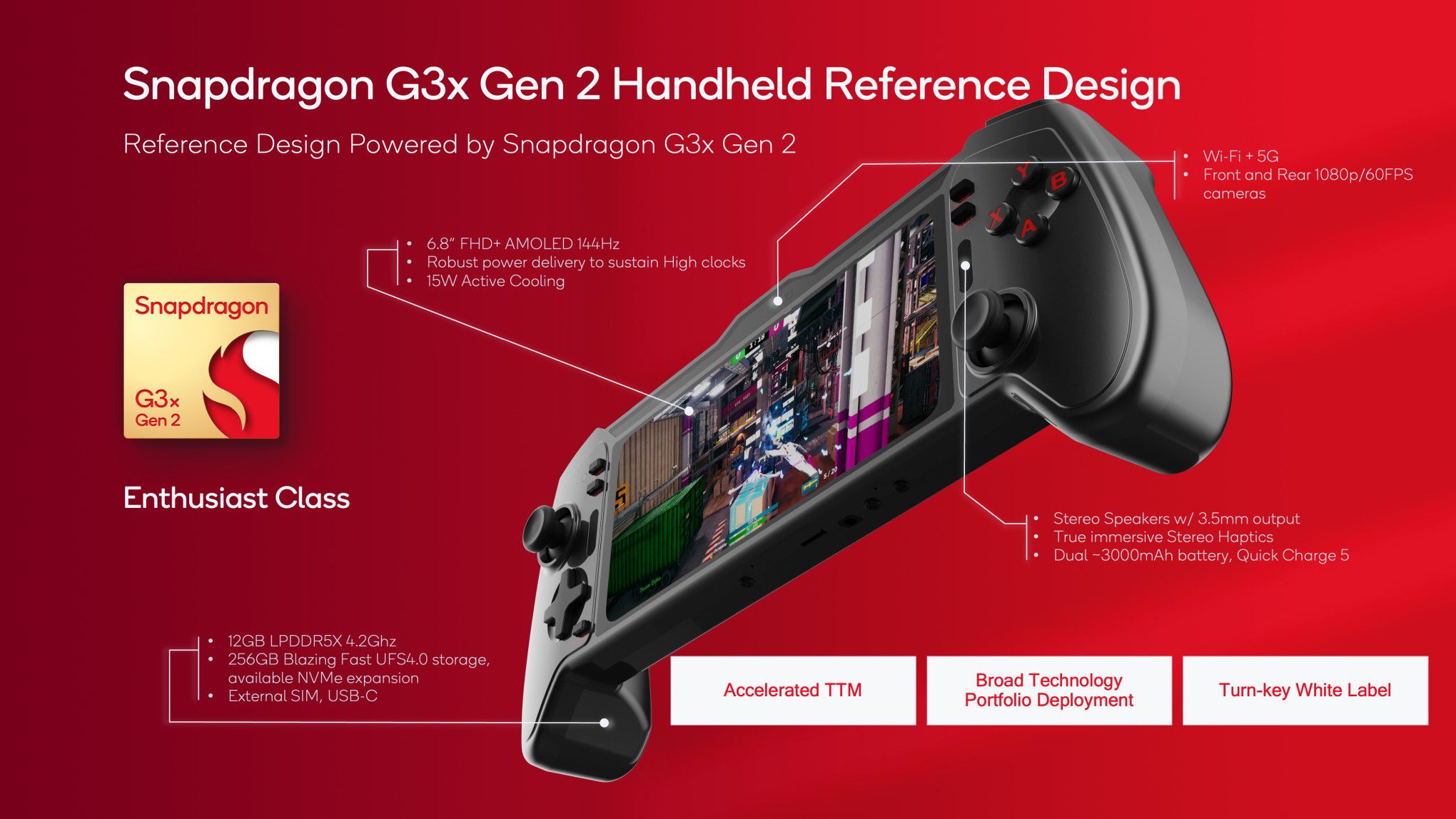Qualcomm's new gaming handheld chip has Steam Deck and AMD in its sights
Much more than merely a souped up phone chip.

Qualcomm has announced a new range of chips aimed squarely at gaming handhelds. The highest spec model, the Qualcomm Snapdragon G3x Gen 2, is said to be over twice as fast as its predecessor. So, can it take the fight to the Steam Deck or even AMD's awesome Phoenix APU in handheld's like the Asus ROG Ally?
The new Snapdragon range for gaming handhelds comprises three chips. Along with the aforementioned G3x Gen 2 are the G1 and the G2. The G1 is an ultra-low power item designed to support game streaming on a handheld rather than running games locally, while the G2 is a mid-tier item analogous to a smartphone processor.
So, we can ultimately dispence with the G1 and G2, they don't move the needle for performance. But what about that Snapdragon G3x Gen 2 beast? How does it compare to the AMD Aerith APU in the Steam Deck or the even more powerful AMD Phoenix chip in the Asus ROG Ally and the plethora of gaming handhelds, new examples of which seem to appear almost daily?
That's quite hard to say given the wildly differing architectures and OS platforms. The G3x Gen 2 rocks an eight-core ARM CPU and peaks at around 15 to 18 watts, which is definitely more Steam Deck than ROG Ally in terms of power consumption. Its Adreno A32 GPU is said to be over twice as fast as that of the G3x Gen 1 as used in the Razer Edge handheld, but it probably needs to be given that is a streaming-focussed device rather than something built to run AAA games locally.
When asked directly by the Verge how the new chip compares to the obvious handheld gaming incumbents, Qualcomm gaming director Mithun Chandrasekhar didn't give a direct response, saying rather bombastically, “I can theoretically crank the performance to 2GHz and beat the living s*** out of other handheld devices, but then you’d get 30 minutes of battery life.”
That implies the G3x Gen 2 is prioritising battery life over outright performance, making it very different to the latest AMD Phoenix-powered handhelds which have very limited run time on battery, especially playing demanding games in higher performance modes.

That said, Qualcomm has produced a reference handheld design based around the chip that looks every bit the Steam Deck killer. It sports a 6.8-inch 1080p-plus OLED sdisplay running at 144Hz, packs 12GB of DDR5 and the chip also supports proper PCIe 4.0-spec SSD storage. So, yeah, this ain't no glorified phone.
Keep up to date with the most important stories and the best deals, as picked by the PC Gamer team.
The real problem for these Qualcomm chips, of course, is software and game support. The number of what you might call high-end games on Android is vanishingly few. Which begs the question of whether Qualcomm plans to support some kind of transcoding platform that could allow Windows games to run on the chip, much like Valve's Proton and Apple's Game Porting Toolkit layers?

Steam Deck review: Our verdict on Valve's handheld PC.
Steam Deck availability: How to get one.
Steam Deck battery life: What's the real battery life of the new device?
How loud is the Steam Deck? And will it pass the Significant Other test?
Steam Deck - The emulation dream machine: Using Valve's handheld hardware as the ultimate emulator.
The simple answer is yes, Qualcomm is working on that. The more complicated answer involving actual details we'll have to wait for.
All said and done, then, the new Qualcomm Snapdragon G3x Gen 2 doesn't immediately seem to have the makings of a Deck killer, much less something that can take on an Asus ROG Ally for pure performance.
Yes, the G3x Gen 2 seems to be pitched roughly at Steam Deck levels of performance, which is no bad thing. It's just that doesn't leave a lot of performance on the table for running non native x86 Windows code in some kind of compatibility mode.
At least when it comes to portable PC gaming, therefore, these new Qualcomm chips probably aren't going to have much impact.

Jeremy has been writing about technology and PCs since the 90nm Netburst era (Google it!) and enjoys nothing more than a serious dissertation on the finer points of monitor input lag and overshoot followed by a forensic examination of advanced lithography. Or maybe he just likes machines that go “ping!” He also has a thing for tennis and cars.

